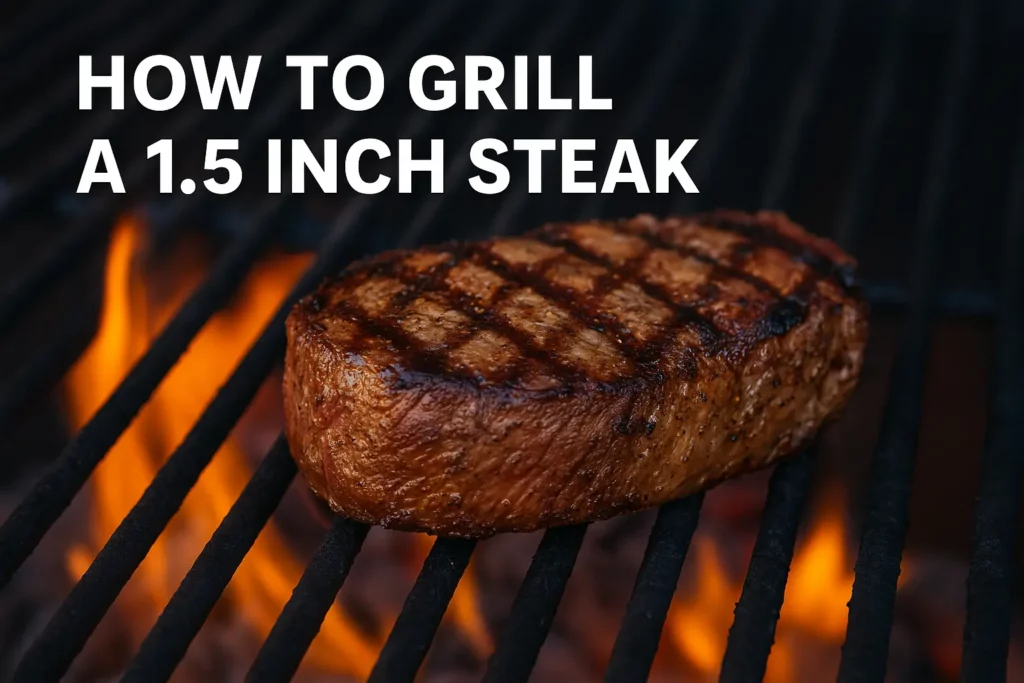This post may contain affiliate links. If you use these links to buy something we may earn a small commission. Thanks.
Grilling steak is more than just placing meat on a hot grate it’s a culinary art that balances heat, timing, and preparation. If you’re working with a 1.5-inch thick steak, congratulations you’ve chosen one of the most ideal thicknesses for grilling. It’s thick enough to allow for a good crust and juicy center, but not so thick that it becomes difficult to manage.
Whether you’re grilling a ribeye, New York strip, or filet mignon, this guide will walk you through everything you need to know to master the perfect 1.5-inch steak on the grill. From prep and seasoning to grilling techniques and doneness, let’s dive into a steak-lover’s dream playbook.
Why Thickness Matters: The 1.5-Inch Advantage
Not all steaks are created equal—and thickness plays a big role in the outcome.
Thin steaks (under 1 inch) tend to overcook quickly, giving you less control over the sear and internal doneness. On the flip side, very thick steaks (over 2 inches) often require advanced techniques like sous vide or reverse searing.

A 1.5-inch steak strikes the perfect balance:
- Enough surface area for a flavorful sear
- Enough interior to control doneness
- Works well with both direct and indirect heat
- Suitable for most steak cuts
In short: If you want a steak that’s juicy, tender, and evenly cooked, 1.5 inches is the sweet spot.
Choosing the Right Cut of Steak
The cut of steak you choose will affect not only flavor and texture but how you grill it. Some cuts do better with quick searing; others benefit from a slower cook-and-finish method.
🥩 Recommended Cuts for 1.5-Inch Grilling:
- Ribeye: Rich marbling, flavorful, forgiving during cooking
- New York Strip: Firm, meaty texture, good marbling
- Filet Mignon: Tender, lean, and elegant
- Porterhouse/T-Bone: Combines strip and filet in one steak; requires more finesse
- Top Sirloin: Leaner, budget-friendly, still very flavorful
🔍 Bone-In vs Boneless:
- Bone-in steaks take slightly longer to cook but offer enhanced flavor and presentation.
- Boneless steaks cook more evenly and are easier to handle on the grill.
🏷 Prime, Choice, or Select?
- Prime (most marbling): Best flavor and tenderness
- Choice (moderate marbling): Great value and taste
- Select (less marbling): Lean but can be dry if overcooked
For best grilling results, aim for USDA Prime or high-end Choice cuts with good marbling.
Preparing the Steak
Proper preparation ensures a flavorful crust, juicy center, and consistent cooking.
1. Thawing
If your steak is frozen, thaw it in the refrigerator for 24–48 hours. Never cook a frozen steak directly on the grill.
2. Bring to Room Temperature
Take your steak out of the fridge about 30–45 minutes before grilling. This allows it to cook evenly.
3. Pat Dry
Use paper towels to blot the steak dry. Moisture on the surface will steam rather than sear.
4. Trim Excess Fat
Remove any large external fat pieces to reduce flare-ups and control smoke.
5. Seasoning Options
- Simple & Classic: Generously apply kosher salt and freshly cracked black pepper.
- Dry Rubs: Add garlic powder, onion powder, paprika, cayenne, or herbs like thyme and rosemary.
- Marinades (if preferred): Use a mix of olive oil, lemon juice, vinegar, garlic, and herbs. Avoid sugary marinades, which can burn on the grill.
For optimal flavor, season 30 minutes before grilling or up to 24 hours in advance if dry brining in the fridge.
Prepping the Grill
A clean, hot grill sets the foundation for a perfect steak.
🛠 Gas vs Charcoal:
- Gas Grill: More consistent heat, easier to control, quicker start-up.
- Charcoal Grill: Rich, smoky flavor, more traditional—but requires more attention.
🧼 Steps:
- Clean your grates: Scrub with a grill brush while the grates are hot.
- Oil your grates: Use tongs and a paper towel soaked in oil to prevent sticking.
- Preheat your grill: Aim for 450°F–500°F.
🔥 Two-Zone Cooking:
Set up your grill with:
- Direct High Heat Zone: For searing
- Indirect Medium Heat Zone: For finishing thicker steaks
This method gives you control over crust development and interior doneness.
Grilling Techniques for a 1.5-Inch Steak
A. Direct Sear + Indirect Finish (Traditional Two-Zone Method)
Perfect for most 1.5-inch steaks.
🔪 Instructions:
- Sear over direct high heat for 2–3 minutes per side.
- Move steak to indirect heat zone and close the grill lid.
- Finish cooking to your target internal temperature (see chart below).
- Use a meat thermometer for accuracy.
This technique creates a deep brown crust and gives you control over internal doneness.
B. Reverse Sear Method
Best for thick or very tender cuts like filet mignon.
🔄 Instructions:
- Start the steak on indirect heat, cooking slowly until it’s 10–15°F below your target doneness.
- Move to the direct heat zone to sear both sides for 1–2 minutes.
- Rest and slice.
This method provides an even temperature gradient and excellent crust.
Internal Temperature Guide & Doneness
Using a meat thermometer is essential—don’t rely solely on timing or color.
| Doneness | Remove From Grill | Final Temp After Rest |
|---|---|---|
| Rare | 120°F | 125°F |
| Medium Rare | 125°F | 130°F |
| Medium | 135°F | 140°F |
| Medium Well | 145°F | 150°F |
| Well Done | 155°F | 160°F+ |
Tip: Insert the thermometer into the thickest part of the steak and avoid touching bone or fat.
Resting the Steak
After grilling, resist the urge to cut immediately. Resting allows juices to redistribute.
🛏 How to Rest:
- Transfer steak to a cutting board
- Tent loosely with foil
- Let it rest 5–10 minutes
Skipping this step can lead to dry, flavorless bites—so be patient!
Slicing and Serving
✂️ How to Slice:
- Always cut against the grain to shorten muscle fibers
- Use a sharp knife for clean, easy cuts
🍽 Delicious Finishing Touches:
- Garlic herb butter: Adds richness and flavor
- Chimichurri sauce: Bright, herby contrast
- Balsamic reduction: Sweet and tangy finish
- Sea salt flakes: For a final crunch
Pro Tips for Grilling Success
✅ DO:
- Preheat your grill thoroughly
- Use tongs instead of a fork to flip
- Let meat come to room temp before grilling
- Use a thermometer to avoid guesswork
- Rest your steak before slicing
❌ DON’T:
- Flip repeatedly—once or twice is enough
- Press the steak with a spatula—it squeezes out juices
- Overcook—you can always cook more, but you can’t uncook
- Use sugary sauces during searing—they burn quickly
Conclusion
Grilling a 1.5-inch steak is all about balance. With the right technique, you can achieve a caramelized crust and a juicy, tender center every time. The keys are:
- Choosing a well-marbled cut
- Seasoning confidently
- Using a two-zone grill setup
- Monitoring doneness with a thermometer
- Letting your steak rest before serving
Whether it’s a weeknight dinner or weekend BBQ, cooking the perfect 1.5-inch steak isn’t complicated it’s a flavorful journey worth mastering.
Now that you know how to grill a 1.5-inch steak like a pro, it’s time to heat up the grill and put your skills to the test.
